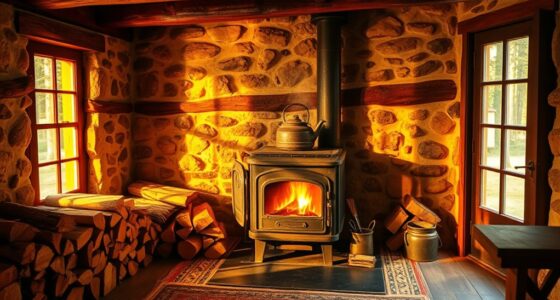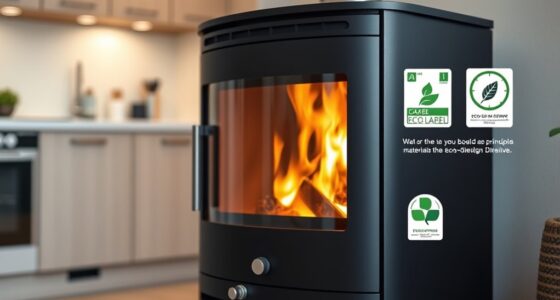The future of eco-friendly wood stoves involves smarter, cleaner technology with innovative combustion systems that cut emissions by over 75%. Stricter standards and certifications push manufacturers to develop more efficient, sustainable models like the Skye E700, which combines digital controls and real-time monitoring. Advances in venting, fuel practices, and AI integration aim for even lower pollution levels. To discover how these innovations can transform your heating experience, explore the upcoming trends shaping greener solutions.
Key Takeaways
- Emerging AI-driven combustion systems will optimize efficiency and emissions in real time.
- Stricter regulations and certifications will push manufacturers toward ultra-clean, high-efficiency stove designs.
- Innovations like secondary combustion chambers and catalytic converters will further reduce particulate emissions.
- Smart monitoring and remote control technologies will enable users to maintain optimal, eco-friendly operation.
- Future models will prioritize sustainability, using advanced venting and emission-reduction tech to meet evolving environmental standards.
Advances in Emission Reduction Technologies
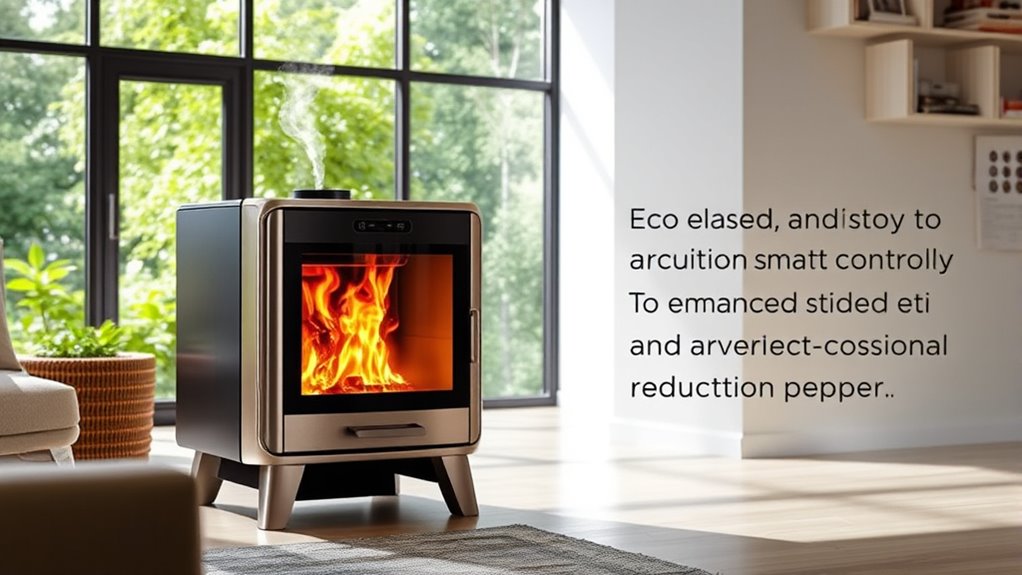
Recent advances in emission reduction technologies have dramatically improved the environmental performance of modern wood stoves. Thanks to innovative combustion technology, these stoves now emit at least 75% fewer particulates than older models. Ecodesign standards have driven manufacturers to develop cleaner-burning appliances, incorporating features like oxygen supply control and complete combustion systems. The Skye E700 exemplifies this progress, utilizing I-Blu combustion intelligence to monitor and adjust in real-time, maximizing efficiency and minimizing pollutants. These advanced systems focus on achieving complete wood burning, drastically reducing CO, PM, and VOC emissions. Enhanced combustion control allows for more precise regulation of airflow, further reducing emissions and improving overall efficiency. Additionally, ongoing research into combustion efficiency continues to push the boundaries of emission reductions, ensuring future stoves meet even more stringent environmental standards.
The Role of Stricter Regulations and Standards

Stricter regulations and standards have become key drivers in transforming the wood stove industry. These regulations, like the Ecodesign standards, require new stoves to reach at least 75% efficiency and drastically cut PM and CO emissions. They push manufacturers to develop cleaner, more eco-friendly models that meet rigorous emission standards. Certification processes such as DEFRA approval and EPA certification ensure only compliant stoves reach the market, fostering innovation driven by legislation. For example, the Skye E700 with I-Blu combustion intelligence exemplifies how regulatory pressure sparks advancements towards ultra-clean burning technology. Ongoing efforts aim to phase out older, high-emission models, creating a market shift toward environmentally friendly, compliant heating appliances. Understanding regulatory compliance plays a crucial role in guiding industry innovation and ensuring consumer safety. These regulations actively shape a more sustainable future for wood stoves, encouraging manufacturers to prioritize emission reduction techniques in their designs. Additionally, ongoing industry regulation updates continue to set higher benchmarks for environmental performance, ensuring continuous improvement in stove technology. Moreover, compliance with these standards often involves adopting new technology innovations, which further accelerates the development of efficient and environmentally friendly solutions. Staying informed about regulatory developments is essential for manufacturers and consumers alike to support sustainable practices in the industry.
Innovations in Combustion and Venting Systems
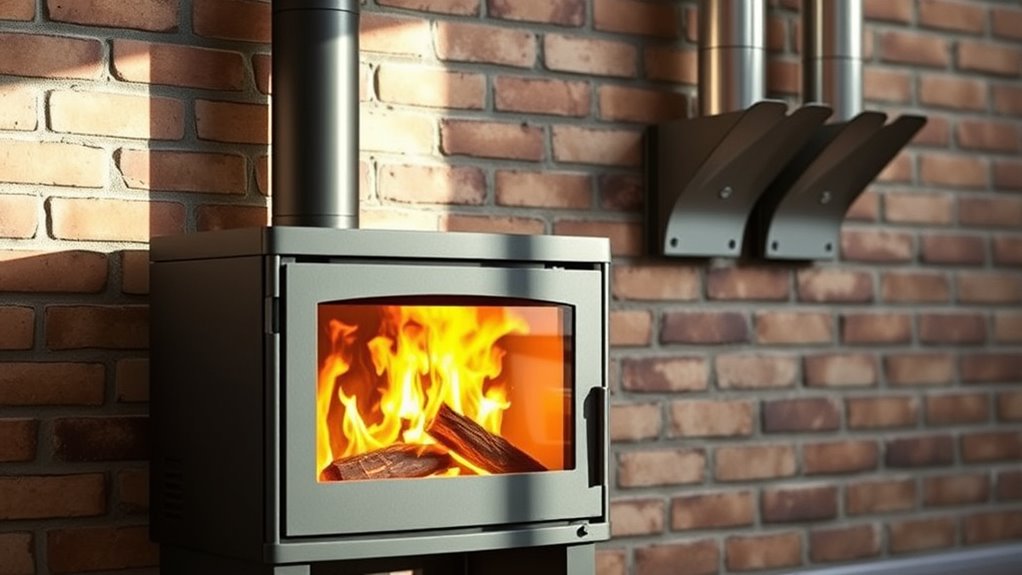
Innovations in combustion and venting systems are transforming how wood stoves operate, enabling them to burn more cleanly and efficiently. Modern combustion technologies, like I-Blu, use real-time sensors to optimize airflow and fuel burn, reaching efficiencies of up to 89%. Advanced venting solutions incorporate sealed combustion chambers and catalytic converters that drastically cut particulate and CO emissions. Innovations such as secondary combustion chambers promote more complete wood burning, reducing harmful emissions by over 70%. This approach not only improves environmental performance but also extends the lifespan of the stove components. Additionally, the integration of digital control systems allows for more precise regulation of combustion parameters, further enhancing efficiency and reducing emissions. Next-generation stoves feature automated controls that adjust air intake and combustion parameters for most favorable performance with minimal pollution. Additionally, integrated smart monitoring systems provide real-time emission data and operational feedback, giving you better control and ensuring environmental standards are met. Implementing advanced monitoring can help identify potential issues early, maintaining optimal performance over time. Incorporating environmental sensors into stove designs can further optimize combustion by adjusting operations based on real-time environmental conditions. These advancements make eco-friendly wood stoves cleaner, smarter, and more efficient. Words of wisdom about the importance of innovation in environmental technology continue to inspire development, leading to smarter and cleaner solutions for sustainable living.
Certification and Certification Processes for Eco-Friendly Models
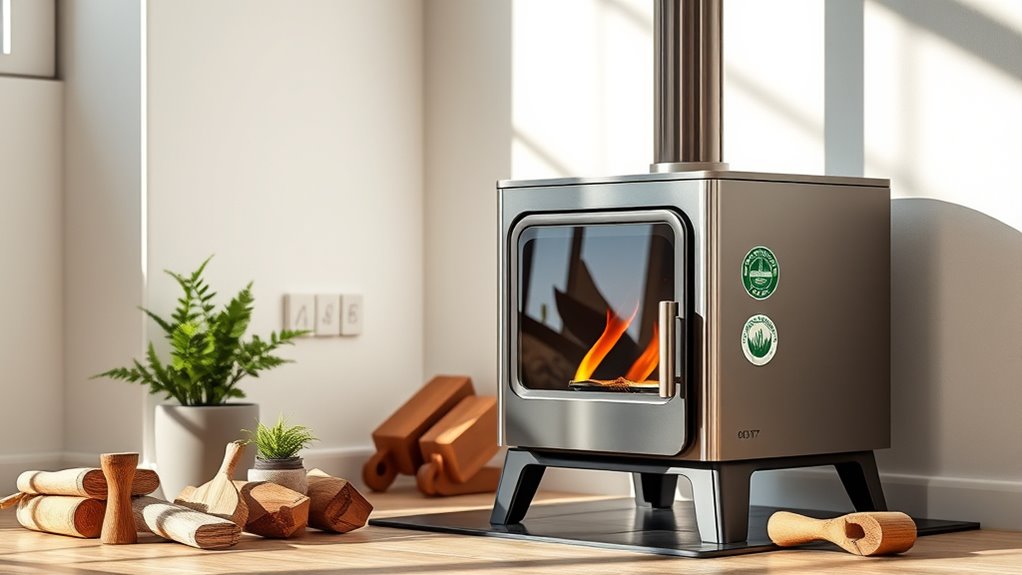
Understanding certification standards helps you identify eco-friendly wood stoves that meet strict emission and efficiency requirements. The certification process involves rigorous testing and inspections to verify compliance with recognized regulations like EPA and Ecodesign. Knowing how these processes work guarantees you choose models that are both safe and environmentally responsible. Additionally, detailed certification standards ensure that only models adhering to high environmental and safety criteria receive official approval. This process also involves independent testing agencies, which help maintain the integrity of certification programs. Staying informed about growing industry regulations can also help consumers select the most sustainable and compliant options available.
Certification Standards Explained
Certification standards for eco-friendly wood stoves, like EPA and Ecodesign regulations, establish strict limits on emissions such as particulate matter (PM) and carbon monoxide (CO). These standards guarantee models reduce pollutants and operate efficiently, typically at least 75%. To achieve certification, manufacturers must submit their stoves for independent testing that verifies compliance with these emission limits. The process includes real-world combustion tests, moisture content checks, and burn cycle analysis to confirm environmental claims. Certification processes ensure that models meet these strict standards through comprehensive testing procedures, which often include evaluations of wood moisture content and combustion efficiency to guarantee optimal performance and minimal environmental impact. Additionally, staying updated on emission regulations helps consumers select models that remain compliant as standards evolve. Regularly reviewing performance testing results can provide further assurance of a stove’s environmental friendliness. Certified models, such as those labeled as DEFRA-exempt or Ecodesign-compliant, meet rigorous emission and efficiency benchmarks. These certification standards help you identify products that prioritize cleaner burning and sustainability, giving you confidence in choosing a stove that’s both eco-friendly and compliant with evolving environmental regulations.
Certification Process Overview
The certification process for eco-friendly wood stoves involves thorough testing by reputable organizations like the EPA, Ecodesign, and DEFRA to guarantee models meet strict emission and efficiency standards. The EPA certification requires models to emit no more than 4.5 grams of particulate matter per hour for non-catalytic stoves and 3 grams for catalytic models, verified through standardized testing procedures. Ecodesign regulation mandates that new stoves achieve at least 75% efficiency and emit less than 40 milligrams of particulate matter per cubic meter, based on European testing protocols. DEFRA approval involves independent laboratory testing to confirm that stoves meet strict smoke control standards, allowing legal use in designated smoke control areas. Throughout the process, continuous quality checks and documentation ensure eco-friendly models maintain standards over their lifecycle. Additionally, understanding the benefits of low-emission appliances can help consumers make more informed choices about environmentally friendly heating options. Implementing rigorous testing standards ensures that these models consistently meet environmental goals and protect air quality. Moreover, the involvement of certification bodies helps uphold transparency and accountability in the industry. Incorporating advanced emission reduction technology can further enhance the environmental performance of these stoves, aligning with future regulatory expectations.
Consumer Awareness and the Shift Toward Sustainable Heating

Have you noticed more people choosing eco-friendly wood stoves lately? Consumer awareness about environmental and health impacts is growing, pushing many toward sustainable heating options. Modern, certified models with advanced combustion emit up to 80% fewer particulates than older stoves. Regulations like Ecodesign and DEFRA encourage cleaner-burning appliances, making eco-friendly choices more appealing. Educational campaigns highlight the importance of using properly seasoned, certified fuels and regular maintenance to maximize efficiency and reduce emissions. The increasing availability of high-efficiency, low-emission stoves like the Skye E700 makes sustainable heating accessible and attractive. This shift reflects a collective effort to prioritize environmental responsibility and health, transforming the way we heat our homes.
| Concern | Action | Impact |
|---|---|---|
| Environment | Choose eco-friendly stoves | Reduce pollution |
| Health | Use certified fuels | Improve indoor air quality |
| Responsibility | Follow regulations | Support sustainability |
Emerging Technologies: The Skye E700 and Beyond

The Skye E700 showcases how advanced combustion monitoring can boost efficiency and cut emissions. By automatically adjusting airflow and combustion in real-time, it minimizes human error and maximizes performance. Future stove designs will likely adopt similar smart systems to enhance sustainability and user experience. Incorporating sustainable practices principles such as mindfulness and intentional design can further improve user satisfaction and environmental harmony. Additionally, integrating personality insights into design processes can foster more user-centric solutions that promote responsible consumption.
Advanced Combustion Monitoring
How do emerging technologies like the Skye E700 revolutionize wood stove performance? They do so through advanced combustion monitoring that continuously analyzes oxygen levels, temperature, and particulate output. This real-time data allows the stove to automatically optimize air supply and fuel combustion, leading to improved efficiency and reduced emissions. The Skye E700 achieves an efficiency rating of 89%, making it one of the cleanest options available. Its I-Blu combustion intelligence ensures the burn process stays ideal, minimizing human error and environmental impact. These innovations not only enhance performance but also help meet strict emission standards. Looking ahead, future developments aim to incorporate AI-driven analytics and remote monitoring, pushing eco-friendly wood stove technology even further.
Emission Optimization Techniques
Emerging technologies like the Skye E700 are transforming emission optimization in wood stoves by leveraging real-time monitoring and automatic adjustments. Its I-Blu combustion intelligence continuously tracks parameters like temperature and smoke levels, enabling automated combustion optimization. This process reduces particulate matter and CO emissions, making your stove cleaner and more efficient. Advanced sensor technology guarantees consistent operation, eliminating human error and optimizing fuel use. Future innovations aim to integrate digital controls and AI algorithms, further enhancing emission reduction efforts.
| Feature | Benefit |
|---|---|
| Real-time sensor tech | Precise combustion control, less emission |
| Automated adjustments | Consistent efficiency, cleaner burning |
| AI-driven algorithms | Continual improvements in emission reduction |
| Digital controls | User-friendly, optimized performance |
Sustainable Fuel Options and Proper Usage Practices
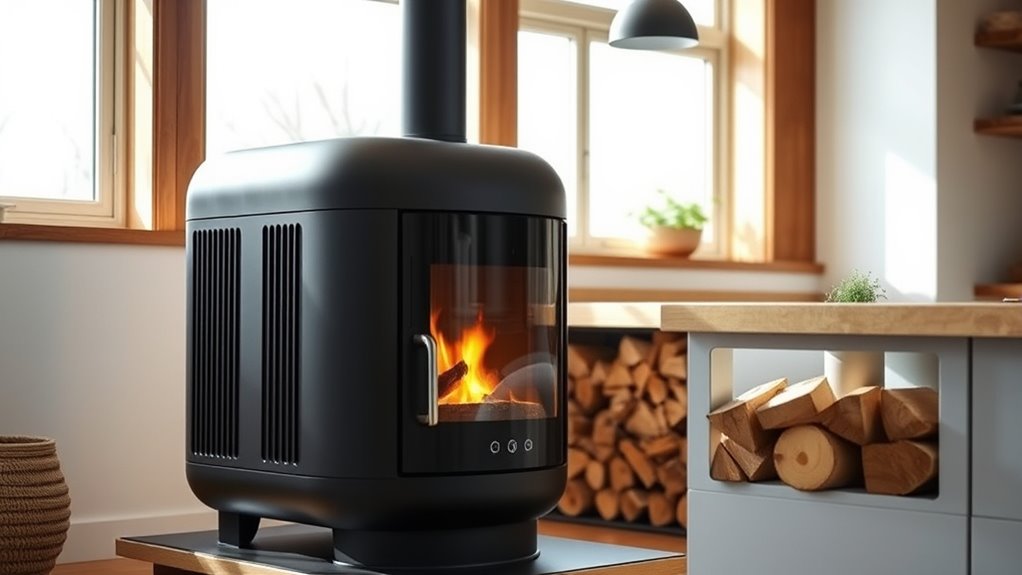
Choosing the right fuel and using it properly are essential steps toward maximizing the eco-friendliness of your wood stove. Using kiln-dried or seasoned wood with less than 20% moisture content considerably reduces emissions and improves combustion efficiency. Proper storage and drying for at least 6-12 months guarantee ideal moisture levels, minimizing smoke pollution. To get the best results, follow these practices:
- Always burn properly seasoned wood to reduce harmful emissions.
- Store wood in a dry, well-ventilated area for proper drying.
- Use moisture meters to regularly test wood moisture levels.
- Avoid wet or green wood, and follow proper lighting techniques for cleaner burning.
The Impact of Ecodesign and Cleanskies Initiatives
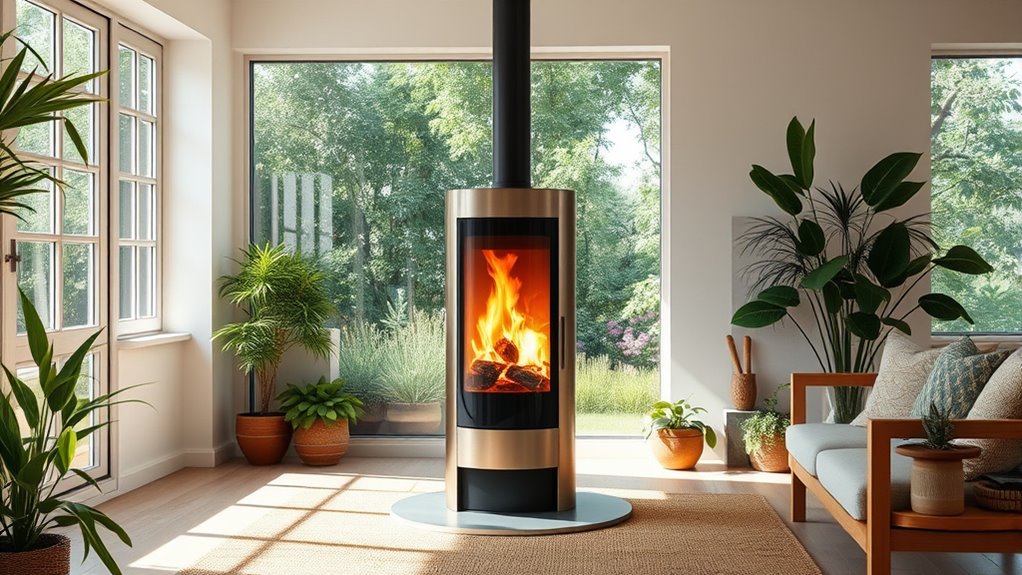
Ecodesign and Cleanskies initiatives are transforming wood stove technology by setting rigorous standards that prioritize efficiency and emissions reduction. These programs push manufacturers to develop stoves that meet strict efficiency benchmarks—at least 75%—while drastically lowering particulate and CO emissions. Modern Ecodesign-compliant stoves, like the Charnwood models, often exceed legal requirements, reaching efficiencies up to 89%, which helps reduce air pollution and energy consumption. Cleanskies initiatives focus on designing stoves that deliver cleaner, more complete combustion, with emissions as low as 1 gram of particles per kilogram of wood burned. Technologies like the Skye E700, equipped with I-Blu combustion intelligence, optimize efficiency and emissions in real-time. Together, these initiatives promote sustainable energy solutions that support climate goals and improve air quality.
Challenges and Opportunities for the Future of Wood Burning Solutions
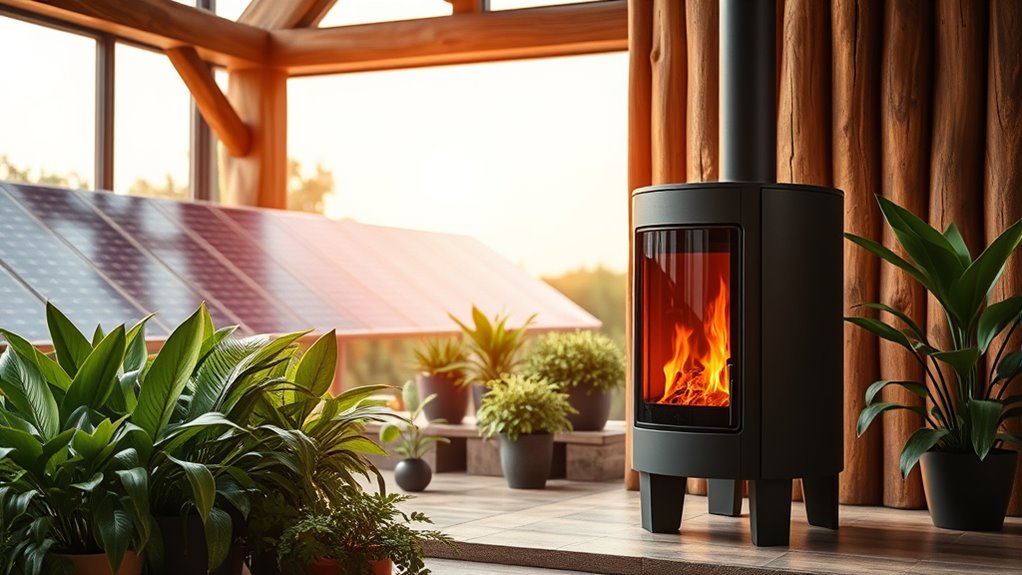
Advancements in combustion technology, like I-Blu systems, offer significant opportunities to reduce emissions and boost efficiency in wood burning solutions. These innovations enable real-time monitoring and optimization, making stoves cleaner and safer. However, challenges remain, especially in balancing traditional aesthetics with new environmental standards. Ecodesign regulations push manufacturers to meet at least 75% efficiency and lower particulate emissions, fostering innovation. The development of cleaner fuel options, such as kiln-dried and seasoned wood, further minimizes pollution. Opportunities include:
Innovative combustion systems and cleaner fuels are transforming eco-friendly wood heating solutions toward greater efficiency and lower emissions.
- Improving combustion technology to enhance efficiency and reduce emissions.
- Meeting stricter Ecodesign regulations through innovative design.
- Promoting cleaner fuel options for better air quality.
- Incorporating digital controls and automation for safer, cleaner operation.
These factors shape the future of eco-friendly wood solutions, balancing tradition with progress.
Frequently Asked Questions
Are There Any Environmentally Friendly Wood-Burning Stoves?
Yes, there are environmentally friendly wood-burning stoves available. These modern, EPA-certified models emit considerably fewer particulates and meet strict efficiency standards. You can choose advanced options like the Skye E700, which uses combustion intelligence to minimize emissions. When properly operated and maintained, these stoves support sustainable heating, are carbon-neutral, and help reduce air pollution, making them a responsible choice for eco-conscious homeowners.
Why Is the Future of Wood-Burning Stoves in Homes Uncertain?
The future of wood-burning stoves in homes is like a ship steering through stormy seas—uncertain and full of challenges. You face stricter regulations, such as emissions and smoke laws, pushing traditional models out of reach. With technological advances and eco-conscious policies, you might see fewer approved stoves. While cultural roots remain strong, environmental concerns and legal hurdles threaten to reshape how and if you can enjoy wood burning in your home.
Do Wood Stoves Contribute to Global Warming?
You might wonder if wood stoves contribute to global warming. When used efficiently with modern technology, they’re nearly carbon-neutral because the CO2 they release is absorbed by new growth. However, if you operate old or inefficient stoves or burn wet wood, emissions increase, contributing to climate change. Proper management and sustainable harvesting help minimize their impact, making them a more eco-friendly choice when used correctly.
Why Is It Not Advisable to Use a Wood Stove?
You shouldn’t use a traditional wood stove because it emits harmful particulate matter that can harm your health and the environment. Incomplete combustion releases toxic gases and pollutants, increasing respiratory risks and contributing to air pollution. Using uncertified or wet wood worsens emissions, and in smoke control areas, you could even face fines. Upgrading to a cleaner, certified stove helps protect your health and reduces your environmental footprint.
Conclusion
As you embrace the future of eco-friendly wood stoves, you’re steering toward a cleaner, greener horizon. Innovations are like a gust of fresh air, transforming your home into a sanctuary of sustainability. With smarter technology and mindful choices, you’ll become a guardian of the environment, turning your heating into a gentle whisper rather than a roaring storm. Together, you and these advancements can write a new chapter in eco-conscious living, one cozy fire at a time.





